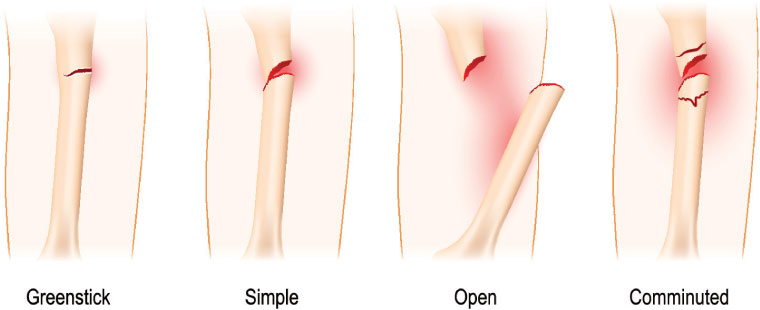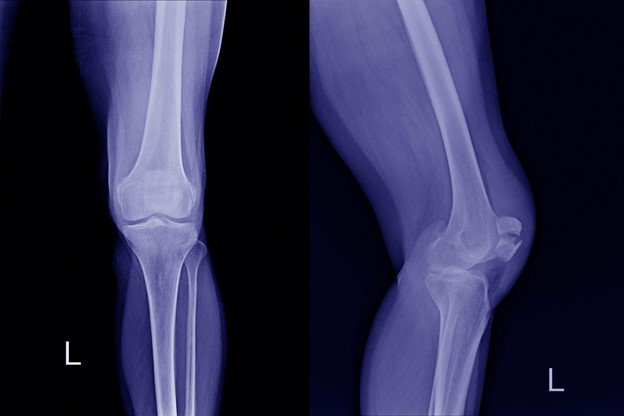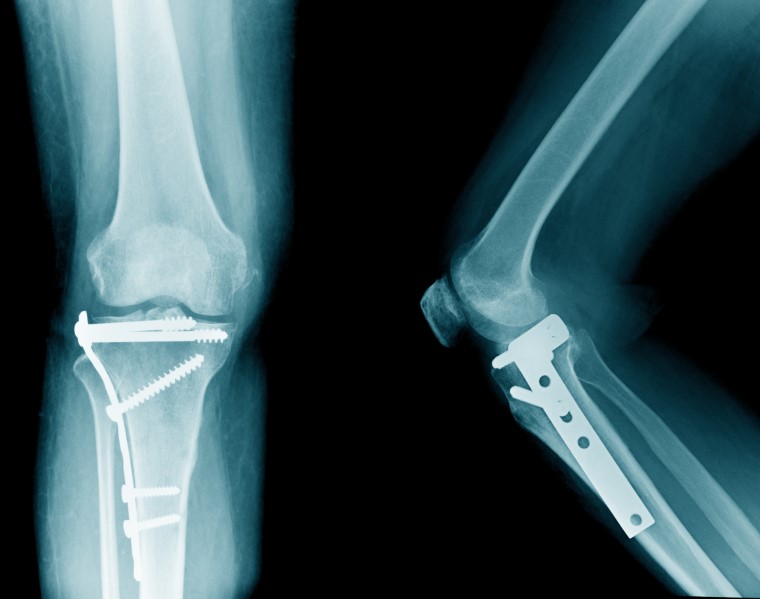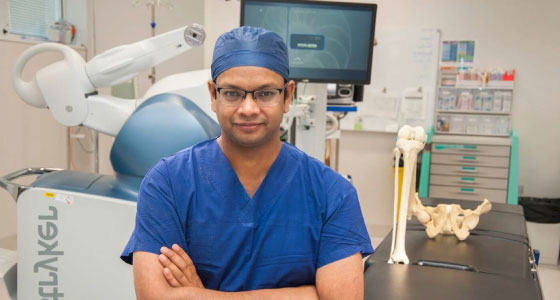The knee joint comprises three bones - the femur (thigh bone), the tibia (shin bone), and the patella (kneecap). Too much stress through physical exertion or direct trauma can result in the fracture of any of these bones causing significant pain, limited function, and for some, joint instability.
Knee fractures vary from simple to complex. A simple fracture is a crack in the bone, whereas complex fractures can result in bones breaking entirely or shattering into multiple pieces. Regardless of the type of fracture you are experiencing, you need to seek out fractured knee treatment. Melbourne residents who have suffered extensive damage to their knee joint as a result of fracture can reach out to us for treatment.
Causes and types of knee fracture
Knee fractures can occur in many different shapes and sizes, ranging from a minute crack in the kneecap to a complete proximal tibial fracture. The main types of knee fractures are explained below:
Distal femur fracture
The distal femur is clinically known as the region from the metaphyseal-diaphyseal junction to the articular surface of the knee. Distal femur fractures most commonly occur in the elderly who have weaker bones, or as a result of direct trauma following impact. Distal femur fractures occur just above the knee joint.
Proximal tibial fractures
The proximal tibia is the upper region of the shin bone where it widens and forms part of the knee joint. There are several types of proximal tibia fractures depending on the fracture site.
- A fracture or break in the shin bone (tibia) is referred to as a proximal tibial fracture. Proximal tibial fractures that occur closer to the knee joint (proximal), can result in joint imperfections, irregular joint surfaces, and improper alignment in the legs, leading to arthritis and instability.
- Tibial shaft fractures can often result in injury to the surrounding soft tissues including blood vessels, nerves, muscles, and tearing of the skin. A tibial shaft fracture often occurs between the knee and ankle joints.
Patellar fracture
A break in the kneecap or patella is known as a patellar fracture. A patella can break in many ways, ranging from a simple crack in the bone to a complete shatter. The main types of patellar fractures are:
- Stable fractures - The bones may remain in contact with one another or have minimal separation.
- Displaced fracture - The broken ends of the bone are misaligned and separated.
- Comminuted fracture - The bone shatters into 3 or more pieces depending on the pattern of the fracture.
- Open fracture - The broken bone tears through the skin and damages the surrounding soft tissue.

A bone can fracture in many ways, warranting different treatments.
Knee fracture symptoms
- Swelling
- Bruising
- Redness and inflammation
- Inability to straighten the leg (depending on the location of your fracture)
- Inability to bear weight
- Infection (most commonly when the skin is pierced)
How are knee fractures diagnosed?
Once you have discussed your medical history and symptoms with your orthopaedic surgeon, they will perform a physical examination to determine the extent of damage caused to your knee. The doctor will assess the function of your knee, determine whether a fracture is present, and then order an X-ray.
X-rays provide detailed images of dense structures such as bones. The images will be taken from a series of angles to allow your surgeon to understand the alignment of the bones. If further damage to the ligaments is suspected, your doctor may order a Magnetic Resonance Imaging (MRI) scan.

X-rays can help determine the extent of your injuries.
Knee fracture and broken bone treatment options
Treating a knee fracture can be complicated depending on the extent of the fracture and your medical history. There is both surgical and non-surgical treatment available for knee fracture treatment. These include:

Non-Operative
If a knee fracture is simple, during which the bones are not displaced, surgery may not be required. Instead, your doctor may prescribe a course of painkillers and apply a cast or splint to keep your bone in place. During this time you should avoid any strenuous movements or weight-bearing.
In most cases, physiotherapy will be prescribed to help you regain mobility.

Operative
The type of surgery performed depends on the type and extent of your fracture. Your options will be discussed in great detail with you during your initial consultation with our surgeon.
Internal Fixation
Internal fixation is performed for both femoral and tibial fractures. During this procedure, the bones are first repositioned (reduced) into a normal position and are then held together using an intramedullary rod or screws.
- Intramedullary nailing - For a femoral fracture, or when only the upper quarter of the tibia is damaged and the joint is not injured, your surgeon may place a specially designed rod through the marrow canal of the injured bone. This rod is then secured into place using screws at either end.
- Plates and screws - Instead of placing a rod, your surgeon will reposition the broken fragments into a normal position and then hold them in place using metal plates and special screws.

The screws and pins hold your bones in place to facilitate healing.
External fixation
In some cases, the fracture may cause significant damage to the surrounding soft tissues. In this instance, the insertion of a rod may cause more harm or damage to the tissue. During an external fixation, your surgeon will place pins and metal screws into the middle of the tibia and femur. These screws are then attached to an external bar to hold your bones into position.
External fixation is a procedure used during an emergency, or if the damage caused is too severe. This allows your bone to heal before an internal fixation or knee replacement is performed.
How Long Is The Recovery Time For A Fractured Bone In The Knee?
Total recovery following a bone fracture varies between individuals. For most, recovery can take approximately 3 months. Recovery involves a combination of:
- Pain medication - you will be prescribed a course of painkillers after your surgery.
- Prophylaxis - depending on your individual circumstances you may be prescribed some blood thinners and/or antibiotics to prevent the formation of blood clots and infection.
- Rehabilitation - we will refer you to an appropriate physiotherapist who will help you regain mobility.
How much does a knee fracture repair cost in Melbourne?
The total cost of your knee fracture treatment in Melbourne will vary depending on the type of treatment you need. The total price factors in the cost of your initial appointment ($200 subject to Medicare rebate) and any follow-up consultations ($100 subject to Medicare rebate).
Your surgeon will provide you with a detailed breakdown of the total cost of your procedure during your initial consultation.
Why choose MOATI and our orthopaedic surgeon
Every member of our staff here at MOATI is dedicated to providing you with exceptional care. Dr Chandrasekaran is a highly trained orthopaedic surgeon in Melbourne who is dedicated to providing patient-centred care. His commitment to quality ensures that you only receive the best treatment tailored to your specific needs.

Dr Siva Chandrasekaran has completed three prestigious surgical fellowships from, USA, Switzerland and the United Kingdom. During this time Siva developed a keen interest in the treatment of hip and knee conditions. He has since published over 50 articles on knee and hip conditions and continues to develop his professional knowledge.
FAQs
Some of the most common questions regarding knee fractures are answered below.
Walking is not recommended on a fractured knee, as any extra stress may cause further misalignment of the bones leading to further injury.
A number of complications can be caused if a knee fracture is left untreated including infection, continuous pain, and a significant reduction in mobility.
The most common symptoms of a knee fracture include pain, limited movements, redness and swelling.
If a fracture is simple, then a cast may help keep the bones in position allowing them to heal on their own.
Elevation can help alleviate pain and discomfort.
According to several studies, patellar and tibial fractures are the most common knee fractures.
